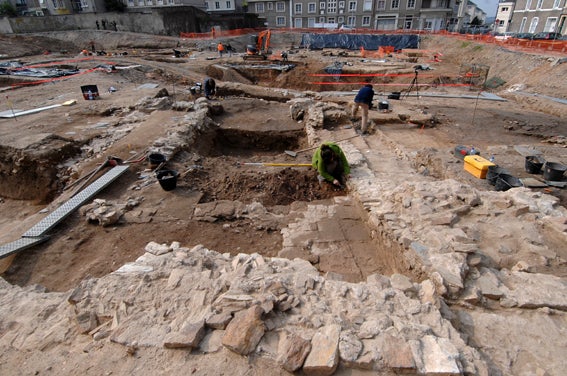Your support helps us to tell the story
From reproductive rights to climate change to Big Tech, The Independent is on the ground when the story is developing. Whether it's investigating the financials of Elon Musk's pro-Trump PAC or producing our latest documentary, 'The A Word', which shines a light on the American women fighting for reproductive rights, we know how important it is to parse out the facts from the messaging.
At such a critical moment in US history, we need reporters on the ground. Your donation allows us to keep sending journalists to speak to both sides of the story.
The Independent is trusted by Americans across the entire political spectrum. And unlike many other quality news outlets, we choose not to lock Americans out of our reporting and analysis with paywalls. We believe quality journalism should be available to everyone, paid for by those who can afford it.
Your support makes all the difference.Archaeologists excavating at Angers, France, have discovered the remains of a temple dedicated to the Indo-Iranian god Mithras. The small, rectangular chapel, in which worshippers gathered for banquets and sacrifices dedicated to the god, is dated to the third century AD.
At the sanctuary, a typical bas-relief of the god Mithras wearing his Phrygian cap shows him slaughtering a bull – the so-called tauroctony. The depiction of the god was intentionally damaged in ancient times, possibly by early Christians trying to suppress the pagan cult.
Among the artefacts discovered are oil lamps, fragments of a chandelier containing Nubian terracotta figures, a bronze 4th century crucifix fibula and about 200 coins. Large quantities of cockerel bones (a favoured dish at the cultic banquets) were found inside and around the ancient temple.
A ceramic beaker – offered by a certain Genialis, in the first half of the 3rd century – reads: “DEO [INVIC]TO MYTRH[AE].../...]VS GENIALIS CIVES MA [...]VS EXVOTO D[.../...]RIBVS OMNIS LOCO OMNIS (...)” or “To the unconquered god Mithras, Genialis, citizen of …, offers in ex voto (this vase)”.
The earliest evidence of occupation at the 9,000 square metre excavation site is dated to about 10 BC. The dig also revealed the remains of two major urban roads; the cardo (north-south oriented street) and decumanus (east-west oriented) axes of Roman Angers.
It is believed the cult of Mithras was brought to the Roman Empire by soldiers coming from the East, at the end of the first century AD. Mithraism, a religion exclusive to men, first became popular with the elite, but quickly spread through all layers of society. Later it became known as a soldier's cult. Shrines dedicated to Mithras are most often found at the borders of the Roman Empire, where large amounts of troops were stationed.
With the rise of Christianity, the worship of Mithras became fiercely opposed. In 392, the Mithraic mysteries – and all other pagan religions – were banned by Emperor Theodosius.
Angers' Mithraeum: Sanctuary dedicated to Persian god Mithras discovered in France
The Temple of Mithras at the heart of Roman London
Enormous Gallo-Roman temple complex unearthed near Le Mans, France

Join our commenting forum
Join thought-provoking conversations, follow other Independent readers and see their replies
Comments